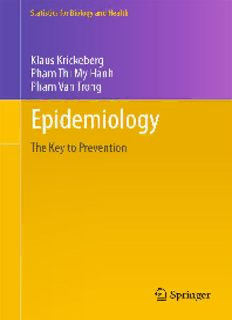
Epidemiology: Key to Prevention PDF
Preview Epidemiology: Key to Prevention
Statistics for Biology and Health Series Editors Mitchell Gail Jonathan M. Samet Anastasios Tsiatis Wing Wong Forfurther volumes: http://www.springer.com/series/2848 Klaus Krickeberg Pham Thi My Hanh l Pham Van Trong Epidemiology Key to Prevention KlausKrickeberg PhamThiMyHanh GrosserKamp4 FacultyofPublicHealth 33619Bielefeld,Germany ThaiBinhMedicalUniversity [email protected] LybonStreet81 ThaiBinh,Vietnam [email protected] PhamVanTrong FacultyofPublicHealth ThaiBinhMedicalUniversity LybonStreet81 ThaiBinh,Vietnam [email protected] ISSN1431-8776 ISBN978-1-4614-1204-5 e-ISBN978-1-4614-1205-2 DOI10.1007/978-1-4614-1205-2 SpringerNewYorkDordrechtHeidelbergLondon LibraryofCongressControlNumber:2011938856 #SpringerScience+BusinessMedia,LLC2012 Allrightsreserved.Thisworkmaynotbetranslatedorcopiedinwholeorinpartwithoutthewritten permissionof the publisher (SpringerScience+Business Media, LLC, 233 SpringStreet, New York, NY10013,USA),exceptforbriefexcerptsinconnectionwithreviewsorscholarlyanalysis.Usein connectionwithanyformofinformationstorageandretrieval,electronicadaptation,computersoftware, orbysimilarordissimilarmethodologynowknownorhereafterdevelopedisforbidden. Theuseinthispublicationoftradenames,trademarks,servicemarks,andsimilarterms,evenifthey arenotidentifiedassuch,isnottobetakenasanexpressionofopinionastowhetherornottheyare subjecttoproprietaryrights. Whiletheadviceandinformationinthisbookarebelievedtobetrueandaccurateatthedateofgoingto press,neithertheauthorsnortheeditorsnorthepublishercanacceptanylegalresponsibilityforany errorsoromissionsthatmaybemade.Thepublishermakesnowarranty,expressorimplied,withrespect tothematerialcontainedherein. Printedonacid-freepaper SpringerispartofSpringerScience+BusinessMedia(www.springer.com) Preface This book is the successor to the textbook “Lessons on Epidemiology” (in Vietnamese) that has been in use at the Medical University of Tha´ı B`ınh since 1990. After a critical analysis of these “lessons” we wrote a completely new text. It is meant for adoption in the first courses on epidemiology in Medical Schools andFacultiesofPublicHealthindevelopingandtransitioncountriesandinwork- shopsinthesecountries,taught,forexample,bymembersofinternationalorgani- zations. It is also suitable for parallel or second reading within curricula in developed countries and for teaching epidemiology in a Master’s programme on “International Health”. The book will enable any lecturer to compose his or her introductory courses on epidemiology by selecting the material deemed appropri- ate.Itwillprovideasolidfoundationformoreadvancedteaching. Hence, the intended readership consists, in the first place, of general medical students; students following the programme “Preventive Physician”that runs par- alleltogeneralmedicalstudiesinsomecountries;studentsstartingtospecializein Public Health; and lecturers in epidemiology. The book can also serve well as an introductiontoepidemiologyforanybodyelseinterestedinthisfield;forexample, staffofhealthinstitutionsandstudentsandlecturersofinternationaldevelopment. Examples and practical work are taken from the present situation of health in Vietnam. Such a coherent setting in one specific country is seen as an advantage, not a drawback; it is preferable to illustrations from many countries that will necessarily remain diffuse and superficial. The book is in fact a large case study thatcaneasilybeadaptedtoanyotherdevelopingortransitioncountry. Thegenerallevelisthatwhichcanbeexpectedofstudentswhowereadmittedto medical studies. The only specific prerequisite is some basic secondary-school mathematics. Above all, the reader should be ready to think; rote learning is not encouraged. When writing the new book we were guided by a few general principles that concern its purposes, its content, and its didactic approach. Let us sketch them briefly. v vi Preface Themainpurposeistogivethereaderaclearpictureofthefundamentalideas thatunderliethefieldofepidemiologyandtorecognizetheirroleinanysituationin practice.Itisonlybybeingfamiliarwiththeseideasthattherightquestionscanbe asked in real situations and the right methods can be chosen to solve practical problems. We emphasize throughout the position of epidemiology as the centre- pieceofPublicHealth;inparticular,Prevention. Also,whenreadingthereportonastudy,studentsofMedicineorPublicHealth shouldbeabletoputitintothecorrectframework,toextracttheessentialsandto judge its significance and correctness. This is all the more important as most studentswillneverhaveanoccasionofparticipatingthemselvesinamajorstudy. They will later on have to base their decisions about practical matters of Public Health,especiallyaboutPrevention,onpublications. Our book is not intended to teach details of techniques. When engaged in an epidemiologic study or faced with an epidemiologic problem underlying preven- tion, health education, outbreak investigation or control of infectious diseases, physicians must know which steps are to be taken and why, but they need not know how these steps look in detail; for that they can consult specialists or appropriatemanuals. Thistextwillalsoprepareitsreaderstousestatisticalsoftwarewithdiscernment. Sincemanydifferentsoftwarepackagesarebeingemployedinvariousinstitutions wehaveneitherrecommendednorusedaparticularone. Onemorepurposeofthebookistolaythegroundforwhatwewouldliketocall “population-sideteaching”,whichisthepublichealthanalogueto“bedsideteach- ing”ofclinicalmedicine;itisrelatedto,butnotidenticalwith,“community-based teaching”. Medical students should help health workers on the primary level to understand simple epidemiologic facts and to describe them and use them if possible. Part of their training can also take place in direct contact with the population. Our text provides much material that lends itself to this kind of teaching. Regardingthecontentofthisbook,thescopeisfairlylargeandcoverstopicsthat play an important role in present day health activities but are rarely treated in existing texts. The topics include registers, health information systems, sample surveys, and elementary statistics. Much attention was of course paid to non- infectious diseases. We have also added some topics that are, in our experience, oftenhandledwronglyintheliteratureandneedtobeelucidated.Neverthelesswe have tried to restrict ourselves to the essentials. Lesson 28 (Outlook) gives an overviewofmoreadvancedsubjectsandareasthatcouldnotbetreatedhere. Atfirstsighttheorganizationofthebookasreflectedinthetableofcontentsmay notlookverysystematic.Itistheresultofdidacticviewpoints.Wedidnotwantto startwithgeneraltheoryandhandleapplicationsafterwards.Insteadwehavetried toplacethetheoreticalbasesattheirnaturalplaces.Thus,inthebeginning,thatisin Lessons 1–10, most fundamental ideas appear only in a specific concrete context. They are explained in an intuitive way, not very rigorously, but sufficiently well sothatthestudentcanunderstandtheirrole.Theoryandmethodsarethenprovided in Lessons 11–17 when the student has already gained some feeling about them. Preface vii Then,armedwiththesetools,wegobacktospecificproblemsbutagain,threemore theoreticalandgenerallessons(20,21,and24)areputinonlylater,whentheyare needed. Thisorganizationalsocorrespondstobasicdifferencesbetweentheepidemiolo- gy of infectious and of non-infectious diseases. Firstly, in the past, epidemiologic thinkingindevelopingcountrieswasdominatedbyproblemsofinfectiousdiseases butatpresentnon-infectiousonesplayanequallyimportantrole.Secondly,modern general and rigorous epidemiologic methods have been established mainly as a response to challenges by non-infectious diseases; whereas, problems of the epide- miologyofinfectiousdiseasescanbehandledtoalargeextentbymoreelementary tools,withtheexceptionofmathematicalmodelling.Thirdly,andmostimportantly, most curative interventions against aninfectiousdisease in a community alsohave anindirectpreventiveeffectbyeliminatingsourcesofinfections;nothingofthekind existsfornon-infectiousdiseases. Thereadershouldbeawareofthefactthatthelessonsonspecificproblemsare determined in two basically different ways: either by the outcome variable as in Lessons6–10and22–23orbytheexposureasinLessons25and26. For didactic reasons, too, we have treated systematically only the action of a single exposure variable, with the exception of Lesson 21 on confounding, where we have explained everything with the help of two examples. Having understood theprincipleoftheactionofoneriskfactor,thereadershouldhavenodifficultyin understanding the essential ideas of the role of several exposures together as they comeupintheexamplesofLessons22,23,25,and26inaninformalway. Similarly,wehaverestrictedourselvesmainlytostudyingbinaryexposureand outcomevariables. A last important didactic viewpoint is the unity of the book. It should not, and cannot, be seen as a collection of more or less independent lessons. In particular, there are very many cross-references, considered as a didactic tool, too. We have notbeenafraidofbeingrepetitiveinsomeplaces. Bielefeld,Germany KlausKrickeberg ThaiBinh,Vietnam PhamThiMyHanh ThaiBinh,Vietnam PhamVanTrong Acknowledgements Several people read part of a first draft and made many useful comments; in particular, Dinh Ngoc Sy, Leˆ Xuan Hung, Pham Ngoc Dinh, Phan Vu Diem Hang, Vu Dinh Hai, Bernhelm Booss, Lena Striedelmeyer, Axel Ekkernkamp, UliSchmucker,andHeikoJahn.NguyeˆnThiThuYeˆnsuppliedtechnicalinforma- tiononspecificpoints.Tworeviewersaddedpertinentremarks.Toallofthemthe authorsowemuchgratitude. Finally, we would like to thank the Else Kro¨ner-Fresenius-Stiftung for their financialsupportthatmadepossibletheprojectofreformingtheteachingofPublic Health in Medical Universities in Vietnam and in the National Institute of Public Health in Laos. Special thanks go to Dr. Carolin Kro¨ner for taking a constant interestandoftenprovidingencouragement. ix
Description: